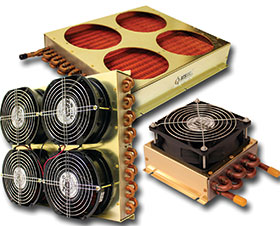Liquid-to-air heat exchangers
14 June 2017
Circuit & System Protection

Advanced Thermal Solutions has released a new line of tube-to-fin, liquid-to-air heat exchangers. Made with the highest density fins to maximise heat transfer from liquid to air, the products allow the liquid to be cooled to very low temperatures.
The heat exchanger fins and tubes are made of copper and stainless steel to be suitable for a variety of fluids, including water, dielectric fluids and custom designed heat transfer fluids. Each of the seven heat exchanger sizes is available with or without a fan. ATS offers 49 options of heat exchangers to meet a variety of needs. Lengths range from 14,7 to 55,6 cm, widths from 14,7 to 35,6 cm, and heights from 4,6 to 6,6 cm. Tube diameters are available at 0,95 and 1,27 cm.
The heat exchangers have silver-solder brazed joints and have been internally cleaned and externally coated for corrosion protection. ATS pressure tests them and can customise them for different fans. They have heat transfer capacities up to 250 W per 1°C difference between the inlet liquid and the inlet air temperatures.
These heat exchangers can be used in a number of applications, including automotive, aerospace, medical, laser cooling, electronics cooling, compressor cooling, semiconductor processing and HVAC.
For more information contact Advanced Thermal Solutions, ats-hq@qats.com, www.qats.com
Further reading:
Varistors for automotive applications
Future Electronics
Circuit & System Protection
TDK Corporation has announced the addition of two new varistors to its AVRH series for automotive applications where both are characterised by the high electrostatic discharge-withstanding voltage demanded to ensure the safe operation of safety-critical automotive functions.
Read more...
Clearing the Static: The importance of ESD wrist straps
Actum Electronics
Circuit & System Protection
ESD clothing plays a pivotal role in preventing that people do not charge the products that they are working with.
Read more...
Clearing the Static: ESD clothing and footwear
Actum Electronics
Circuit & System Protection
ESD clothing plays a pivotal role in preventing that people do not charge the products that they are working with.
Read more...
Single-phase EMC filters
RS South Africa
Circuit & System Protection
TDK Corporation has expanded its portfolio of single-phase EMC filters for AC and DC applications up to 250 V and rated currents from 6 to 30 A.
Read more...
Clearing the Static: The significance of cleaning in ESD control
Actum Group
Circuit & System Protection
It is essential that ESD-protected workplace areas and equipment (tables, floors, work mats, trays, tools, machine elements) are cleaned with specialised antistatic cleaners.
Read more...
Clearing the Static: ESD protective packaging
Actum Group
Circuit & System Protection
The primary objective of ESD protective packaging is to prevent ESD incidents within the packaging and facilitate the dissipation of charges from the outer surface.
Read more...
New NeoMesh protocol stack version
CST Electronics
Circuit & System Protection
NeoCortec has released an updated NeoMesh protocol stack version 1.6 firmware for its NC2400 and NC1000 module series, which now supports the new Sensirion SHT4xA temperature and humidity sensor series.
Read more...
NewFeed feeder protection relay
NewElec Pretoria
Circuit & System Protection
The NewFeed Feeder Protection Relay has been designed to protect the connection between solar farms and conventional power grids in both low voltage (LV) and medium voltage (MV) distribution settings.
Read more...
Clearing the Static: Fundamental principles of static control
Actum Group
Circuit & System Protection
The use of grounding products and testing equipment becomes essential to verify the proper functionality of static control systems in the work environment.
Read more...
Clearing the Static
Actum Electronics
Circuit & System Protection
The use of grounding products and testing equipment becomes essential to verify the proper functionality of static control systems in the work environment.
Read more...

